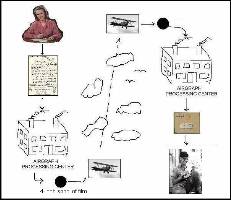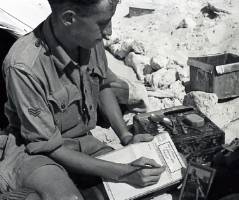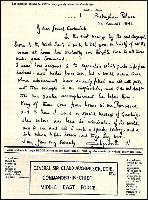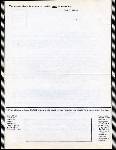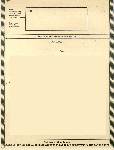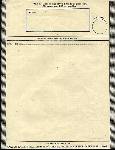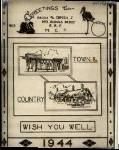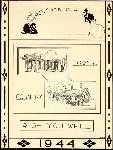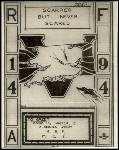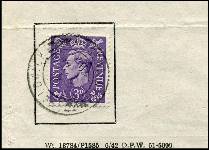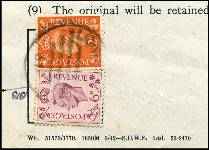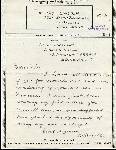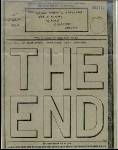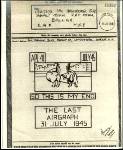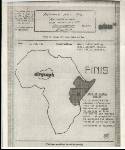

A is for AIRGRAPH |

|

|

|
 |
THE AIRGRAPH SERVICE (17 April 1941 to 31 July 1945)
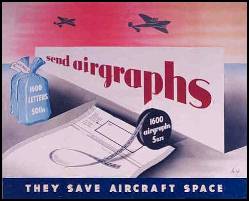
Airgraph propaganda poster, 1942
|
THE PROBLEM In the early months of World War II, the Ministry of Transport in Great Britain was faced with serious problems in maintaining a postal service for forces stationed in the Middle East (GB controlled the Suez Canal from 1882 to 1952). After the French surrender to Germany in May of 1940, and with Italy a key Axis member, the western and central Mediterranean were under Axis control, with key parts of North Africa also Axis-dominated, thus closing the short route to the Atlantic. The preferred alternative was to send mail by air, but space for mail by air was extremely limited, so letters to and from the Near and Far East were taking 3 to 6 months to reach their destination by the only method remaining - via ship around the southern tip of Africa. |
|
The basic concept was simple. Letters were photographed on the sending end, then the negatives were sent by air to the destination end, where they were printed and delivered. The volume and weight of the film were less than one fiftieth of the volume and weight of the letters, so a large number of letters could be transported quickly at a relatively small cost. The Kodak office in Cairo already had the equipment required to photograph the letters, and was able to start processing almost at once. Airgraph service started from Cairo on April 21, 1941, arriving in London May 13. That first shipment comprised some 70,000 letters, a testament to someone's efforts to sell the concept. About 350,000 messages were sent during the first month of the service and over 500,000 in the second month. |
|
A similar concept had been in use by the French as early as 1870, to transport mail by carrier pigeon into and out of the besieged city of Paris (though the images were projected onto a screen and transcribed by hand on the receiving end). At left, privately printed Xmas message, 1943, with news article about the French Airgraph precursor. |
It took a while to establish service in the other direction, though, as getting Cairo set up to transmit had been the first priority, and getting London set up to transmit turned out to be more complicated. By the time the first dispatch left London nearly 1,000,000 Airgraph messages had been received in Britain, that from official records. The first Airgraph from the UK was sent in August by Her Majesty Queen Elizabeth (wife of King George VI and mother of the current Queen) to General Sir Claud Auchinleck, Commander-in-Chief, Middle East Forces, conveying a formal message to inaugurate the service. Shown below, it has serial number one!
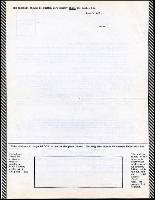
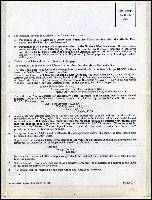
Earliest Airgraph form Address box at bottom |
There were objections to the idea, of course. The letters had to be written on special forms that had been designed to work with the processing equipment, and the maximum length of a message that one form would hold was only a few hundred words ( detailed instructions were on the back side of the form). The form was not to be folded, and had to be handed in at a post office, and then handled first by censors, then by sorters and other processing personnel, and some people were sure everyone who handled the forms would read them, and private details of one's life would be known. Nonetheless, the system caught on, and by the end of the War, over 330 million Airgraphs had been processed. As you can see in the instructions, those who were concerned about loss of privacy had the option of mailing the form to the London GPO Foreign Section, but had to bear the cost of an envelope plus extra postage. It is not known how many chose that method. Starting some time in 1942, the instructions changed slightly. The amount of the fee is not stated, presumably to accommodate the new civilian service, which had a different fee, 8d instead of 3d. |
|
The forms themselves were free of charge from Post Offices. Indeed, anyone could produce their own forms, if they complied with the size and layout of the official issues. Such private forms were rare, as paper and printing ink were scarce. Troops overseas were issued forms free, how many depending on the command in which they served, and conditions at the time. To the left are examples of three hand-made Airgraphs, all by the same enterprising civilian. (All of these images and their descriptions below are courtesy of Alan Berman. The references in brackets are page numbers in Keeton's book.)
It may be hard for anyone under forty to imagine a time when there weren't copy machines everywhere, but in the 1940's even the crudest copying was available to very few. Perhaps Mr. Dear had access to facilities of the township. |
The A to Z of Airgraphs: Foreign Forms
Airgraph forms were produced in many countries, from Aden to Zanzibar, wherever needed, and in whatever language was appropriate. Troops stationed there would use these local forms, which were then sent to the nearest processing station. The basic format of all forms had to be the same, of course, to conform to the processing system. Forms printed outside the UK can be identified in various ways - some by mention of local currency, others by variations in the instructions, or by local postage imprints (see below).

Airgraph form printed in India - "postage is 3
annas."

Airgraph form printed in India - "postage is 3
annas."
|
Note that each form needed to have 3d postage affixed (later, 3d for mail to service personnel, 8d for mail to a civilian). Mail to servicemen On Active Service was sent at the normal UK inland rate and this is still the case today for Iraq. These charges applied to civilians only. Military personnel on active duty were allowed to send Airgraphs (and all other correspondence) free of charge. The postage affixed to forms submitted by civilians was cancelled at its point of entry, as proven by the fact that all the extant used forms sent by ordinary mail have either local or field post office cancels. Images to the right - Cancelled stamps on Airgraph forms. These are scarce, since forms were destroyed once filmed. Most that survive are ones either returned for some reason, or forwarded as ordinary mail because Airgraph service was not available to their destination. |
|
Development of Airgraph service was hampered by the shortage of specialized equipment and the need to ship materials overseas in order to install processing stations abroad. However by April 17, 1941, arrangements were sufficiently complete to start services from Cairo, with mail from the Middle East Forces. The first films from the outgoing facility in Cairo reached London for processing in early May, earliest date recorded from the postmark on a delivery envelope being 13th May 1941. From posting to receipt (date on letter, date of postmark) took approximately three weeks for microfilming, transit, enlarging and delivery, although longer and shorter periods are known. During the life of the service all films incoming to the UK were processed and prints made at Kodak's Wealdstone factory. Initially they were manually inserted in special envelopes and passed to the Post Office for the application of the "Post Paid" cancellation before normal delivery. UK ENVELOPE TYPES There are four major types of UK Airgraph envelopes, with 15 varieties
|
Forms were destroyed once it had been confirmed that a film had been received, processed and satisfactory prints made. Thus apart from those returned to the senders, and a few which were sent by ordinary mail, properly used Airgraph documents are exceedingly scarce, and are highly prized by collectors.
The few used forms that are seen are usually those returned to sender, and usually have an explanatory note or handstamp giving the reason for the return. From within the UK, the following handstamps are known: "NO SERVICE - POSTAGE REPAID," "TRANSMITTED BY ORDINARY MAIL - NO AIRGRAPH SERVICE AVAILABLE TO ADDRESS," "AIRGRAPH SERVICE NOT AVAILABLE TO LOCATION OF SHIP - FORWARDED BY ORDINARY MAIL." Similar manuscript endorsements are known from other theatres, but forms with any endorsement or handstamp are uncommon.

|
As delivered to the addressee, Airgraphs were not much to look at. Their appeal to most people today lies in the veiled stories their messages tell, of the hardships and loneliness of war. Millions of Airgraphs survive, and provide a poignant history of individuals caught up in the deadliest conflict humanity has known. |
|
HANDSTAMPS TELL TRAGIC STORIES To a collector, the most interesting Airgraphs are those with special markings that reveal something unusual - and often tragic - about an Airgraph's journey. Those stamped "RETURN TO SENDER" tell the saddest stories.
At right -
AIRGRAPHS LOST IN TRANSIT - REPRINT A rare Airgraph handstamp is "REPRINT" (no example available) which is usually found on the back of an Airgraph, indicating that the original film had been lost in transit. In September 1942, for example, the Short C-Class Empire flying boat "Clare" was lost while carrying parcels and 55,000+ Airgraphs from India, East Africa, and South Africa. (Destroyed by engine fire in the air off Bathurst, West Africa 14th September 1942) The Airgraphs, which amounted to 35-plus films, were re-photographed, sent to the UK, processed and dispatched to the addressees within 10 days and should have been handstamped "REPRINT", but for some reason this was not done. |


Returned Airgraph (MEF) - MISSING
|
THE END OF THE "CLARE"CZ CLARE departed Lagos at daybreak for Bathurst, refuelling at Freetown. At Bathurst ?CZ was refuelled and a new crew (Captain Musson, First Officer A.D.C.Jenkins, Second Officer A.O.Cundy,& Radio Officers E.F.G.Brent & J.A.Wycherly) took over for the sector to Lisbon. Captain Musson liked to fly tangents to a 60 n.m.circle round Dakar. One hour out of Bathurst the Captain decided to return, having lost an engine. Minutes later a request for ?Flares? was followed by ?SOS Fire?. ?CZ CLARE crashed in the dark some 30 minutes flying time from Bathurst. The next day all available aircraft searched without success. On 16 September a BOAC Catalina (Captain J.C.Parker, Second Officer Talbot & Navigator D.McGregor) searched to the west of the assumed track - McGregor had flown with Captain Musson ? finding six bodies and wreckage.
From FLYING EMPIRES by Brian Cassidy (click on link to download pdf of the book)
|
Undoubtedly the richest, most varied, and most visually appealing area in the field of Airgraphs is that of Illustrated Greetings which, starting as early as Christmas 1941, were issued by Regiments and Commands. A master form was prepared with a humorous or sentimental theme, then duplicated and distributed. Often the design left space for little more than a signature - they were the WW II equivalent of Hallmark cards. Others were "one-off" drawings by the sender, and in some cases even Postal Authorities issued them. Sometimes it's hard to tell which of these are one-offs and which mass-produced. There were a lot of talented drafts-men and -women in the services. So unless we find multiple copies of a design (or a blank form!), we can't be sure it isn't unique. Apart from an early catalogue by Stephens, (1948) no work has been published detailing them, and this is still an active area of research, as many new illustrations have been found and indeed are still being found. "Airgraph," by E.H. Keeton (1987) deals more with the actual service and ordinary types, but does show a few pictorial types as well. If you wish to see a lot more illustrated Airgraphs - or purchase a few - go to the web site of Alan Berman, dealer in UK postal history, who has an exceptional stock of Airgraphs, and includes them regularly in his auctions. |
|||
|
B.P.O. XMAS AIRGRAPHS For Christmas 1943 and 1944 the British Post Office issued official Airgraph holiday forms in the UK. The 1944 form bore a violet 3d imprint stamp (whereas all other UK forms had a space for a stamp to be affixed). This form was available at post offices for the cost of the postage - 3d (all others were free). |

Official B.P.O. Airgraph for Xmas 1944 |


|
|
|
The ability to send photos on Airgraphs was popular enough that an effort was made to provide such a service. In early 1943, Dufay-Chromex, a film manufacturer, announced their system for putting photos on Airgraphs. It involved photographing the subject, then printing the photo onto a form, a process that took several weeks, and was both labor-intensive and costly. An article in the May 7, 1943 Manchester Daily Sketch:
Based on the survival rate of the Dufay-Chromex Airgraphs today, the idea did not catch on. It was expensive, 3/9d vs. the basic 3d for a forces Airgraph. It was unpopular, however, not primarily because of cost, but because of the great number of forms one was required to fill in. The Government of course kept a very tight control of all chemicals and photographic materials during the war. |

Dufay Process news article and example |
CANADA
In November 1941, Canada initiated its own independent Airgraph service, which lasted until July, 1945. But that's another story.
V-MAIL
Inspired by Great Britain's example, the USA instituted its own version of the Airgraph, called V-Mail. For much more about that, please visit my V is for V-Mail page.
CREDITS
This page is based on an article by Stephen Dunderdale, noted Airgraph collector in the UK, who also supplied most of the images for this page.
The premier Airgraph dealer is Alan Berman, dealer in UK postal history, whose stock features an exceptional selection of Airgraphs. He also conducts regular auctions, which usually include important Airgraph material. Alan most graciously consented to my use of images from his web site, all of which are credited above - let your mouse arrow rest over any image for more information about it. Visit Alan's web site to see over a thousand images of Airgraphs and related material, most of it for sale.
REFERENCES
AIRGRAPH, by E.H. KEETON, pub. January 1987, Forces Postal History Society, 260pp. This details all the known types of Airgraph forms, listing them by country or area in which they were produced.
LINKS
Below are links to other sites with information and images about Airgraphs.
AIRGRAPHS - by Malcolm Sander (no longer available)
History of the Second World War Army Postal Services (1939-45) at the Royal Engineers Museum web site. (No longer available)
Airgraph Material at the British Postal Museum & Archive
The Postal And Courier Service - BFPO HISTORY (No longer available)
| Home | A is for AMG <<< | Contents | >>> B is for Bisect | Credits |
All text Copyright © 2007, William M. Senkus
Send feedback to the webmaster: CLICK HERE
Created -- 5/14/2007
Revised -- 8/06/2025


